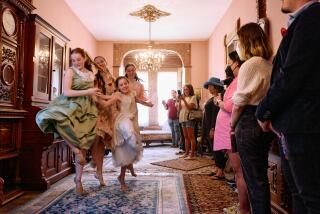Americans, Canadians Honor Modern, Classical Masters
- Share via
A need to honor and showcase groundbreaking 20th century masters united two excellent but otherwise dissimilar programs on campus stages over the weekend, with major moderns invoked by the American Repertory Dance Company at El Camino College on Friday and their classical counterparts celebrated by Les Grands Ballets Canadiens at Cal State L.A. on Saturday.
If the visiting Canadians sometimes focused more on defining choreographic styles than mining expressive riches, they’d only been dancing this program since the beginning of the month and the foundations for future distinction looked secure. For instance, Kurt Jooss’ 1932 antiwar dance-drama “The Green Table” (music by F.A. Cohen) needs to be driven by the continual, startling reappearances and rhythmic force of the dancer portraying Death. But with Olivier Wecxsteen muted in that role except for his scene with the Profiteer, nobody could make this neo-Expressionist masterwork as harrowing as has been in the finest Joffrey Ballet performances.
When you looked closely, you could see the Mother’s anguish, the Young Girl’s hopelessness, the Partisan’s courage, the Standard Bearer’s fight against his body’s collapse all outlined carefully in the performances of Amanda Michelle Cyr, Stephana Arnold, Kiyoko Gotanda and Alejandro Alvarez. But the attacks remained cautious and the emotions not fully embodied--not yet.
Similarly, in a meticulous but chilly run-through of Antony Tudor’s 1936 dance drama “Lilac Garden” (music by Chausson), Anik Bissonnette failed to heighten the torment of a young woman facing a loveless marriage, letting major interpretive choices pass by unexamined. A long full-company frieze that represented the character’s last moment of free will remained incomprehensible here because Bissonnette had always seemed merely a passive victim of circumstance.
Vadim Bondar (the intended groom), Jeannette Marie Hanley (his mistress) and the supporting cast danced skillfully, but the ballet’s neo-Romantic atmosphere suffered from a set by Tom Lingwood most suitable for lions than lilacs.
*
David Bushman underplayed the ardor of the young woman’s lover just as he underplayed the menace of the Profiteer in “The Green Table.” But he exuded plenty of twisted, devious energy in the Iago role of “The Moor’s Pavane,” Jose Limon’s 1949 four-character abstraction of Shakespeare’s “Othello” (music by Purcell). Perhaps the most rounded and accomplished performance, however, came from Nanci Crowley as Iago’s wife.
Shawn Hounsell worked hard to give Othello authority as well as passion, but Andrea Boardman never found much more than lyrical prettiness in the role of the victimized wife, nearly always the work’s least interesting character.
A gracious Genevieve Guerard and a hard-working Jeremy Raia led the six-member cast of George Balanchine’s deceptively airy 1969 “Valse Fantaisie” (music by Glinka), a plotless divertissement punishing in its nonstop technical fireworks. Canadian honor survived intact but nobody made it look easy. No doubt ease, theatrical scale and expressivity will all improve by the end of the current U.S. tour, for this is a company of beautifully trained and committed young artists.
*
In a new edition of its familiar “Indomitable Spirit of Woman” evening of solos and duets, American Repertory Dance Company went beyond mere academic reconstruction by presenting John Pennington in “On the Brink of Time” (music by Morton Subotnick), a technically challenging 1969 Bella Lewitzky solo previously danced only by Lewitzky herself.
Here was the choreographer’s indomitable spirit recalled and renewed in a male body, stylistically informed by Pennington’s 14 years in the Lewitzky company yet individual, too: much more intently projected to (or dramatized for) the audience than Lewitzky’s drier virtuosity, if memory serves.
The company also reconstructed Anna Sokolow’s graceful 1980 solo “Preludes” (to Rachmaninoff), danced lovingly by Nancy Colahan as if every eloquent arm position, every shift in scale--from expansive to intimate--represented the key to some precious secret. Colahan also used her sensitivity to body sculpture in Eve Gentry’s 1936 character study “Tenant of the Street,” enhancing its stylization of stance without compromising its social commentary.
Among the otherwise previously reviewed offerings, Diana MacNeil took on Sophie Maslow’s 1941 solo “Dust Bowl Ballads” for the first time, arguably softening (sentimentalizing?) its sense of homelessness, but achieving a remarkable fusion with the Woody Guthrie songs that formed its accompaniment. Works by Agnes de Mille, Lester Horton, Helen Tamiris and Mary Wigman completed the program.
More to Read
The biggest entertainment stories
Get our big stories about Hollywood, film, television, music, arts, culture and more right in your inbox as soon as they publish.
You may occasionally receive promotional content from the Los Angeles Times.










